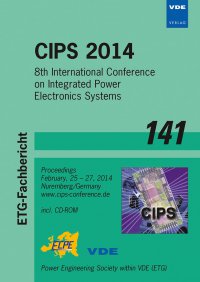Influence of Cu/Ni(P) Metallized Si3N4 Ceramic Substrate in Bond Reliability of Power Components at 250 °C
Conference: CIPS 2014 - 8th International Conference on Integrated Power Electronics Systems
02/25/2014 - 02/27/2014 at Nuremberg, Germany
Proceedings: CIPS 2014
Pages: 6Language: englishTyp: PDF
Personal VDE Members are entitled to a 10% discount on this title
Authors:
Lang, Fengqun (R&D Partnership for Future Power Electronics Technology (FUPET), c/o AIST, Central 2, 1-1-1, Umezono, Tsukuba, Ibaraki, 305-8568, Japan)
Yamaguchi, Hiroshi; Nakagawa, Hiroshi; Sato, Hiroshi (R&D Partnership for Future Power Electronics Technology (FUPET), c/o AIST, Central 2, 1-1-1, Umezono, Tsukuba, Ibaraki, 305-8568 Japan __ Advanced Power Electronics Research Center, National Institute of Advanced Industrial Science and Technology (AIST). Central 2, 1-1-1, Umezono, Tsukuba, Ibaraki, 305-8568 Japan)
Abstract:
Active metal bonded copper (AMC) on Si3N4 ceramic substrate was used to fabricate the high temperature resistant power components. The high temperature reliability of the substrate and its influence in bond reliability of the power components were investigated under isothermal storage conditions at 250 °C for up to 3000 h and thermal cycling conditions from -40 to 250 °C for up to 3000 cycles. During isothermal storage at 250 °C, the AMC substrate exhibited high reliability, characterized by very little copper (Cu) layer deformation, very low cracks growth rate and Cu oxidation rate of the Cu layer. As a result, the bond strength of the power components slowly decreased with storage time, from the original 83 MPa to ~60 MPa after 3000 h. Under thermal cycling conditions from -40 to 250 °C, no detachment of the Cu layer was observed even after the maximum 3000 cycles of the experiment. However, serious deformation of the Cu layer occurred and proceeded with number of the thermal cycles. In addition, the thermal stress led to significant increase of the surface roughness, rapid crack growth rate and high oxidation rate. The deformation of the Cu layer was the main cause responsible for the decrease of the bond strength under thermal cycling conditions. The shear strength decreased to 33 MPa after 3000 cycles.


